Northrop Grumman assumes full GMLRS rocket motor production
Northrop Grumman Corporation (NYSE: NOC) will assume production of rocket motors for the U.S. Army’s Guided Multiple Launch Rocket System (GMLRS), fulfilling the full contract production quantity — the company recently delivered its 15,000th rocket motor and 20,000th warhead to Lockheed Martin for final assembly.
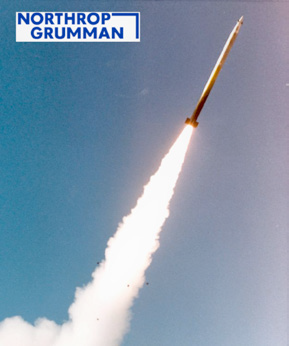
The propulsion system, once delivered to Lockheed Martin’s Camden, Arkansas, final assembly facility, will be integrated into GMLRS missiles — a ballistic rocket designed to engage targets from 15 to 70 kilometers.
Northrop Grumman’s safety enhancing, insensitive munition provides the system structural integrity under extreme conditions such as heat, shock and adjacent detonations. The ignition safety device further improves the weapon system’s safety characteristics by preventing unwanted combustion.
Northrop Grumman designed and constructed a purpose-built manufacturing facility at the Allegany Ballistics Laboratory in Rocket Center, West Virginia., using lean manufacturing and digital engineering techniques which enables a robust and resilient Defense Industrial Base.
The facility provides for the efficient design, development and production of this critical weapon system component.
“We are proactively investing in production facilities and technologies in support of producing even higher rates of rocket motors faster and more affordably to meet our customer’s anticipated demand,” said Jim Kalberer, vice president of missile products, Northrop Grumman. “We are leveraging our capacity and modern manufacturing facilities to deliver critical military needs.”
“Northrop Grumman is a trusted supplier of GMLRS rocket motors with robust manufacturing capacity to meet the demands of our customer,” said Jay Price, vice president of Precision Fires for Lockheed Martin.
Speedcast wins APAC teleport services contract from Airbus and The UK MoD
Speedcast has been awarded a contract extension by Airbus to provide gateway hosting services offering secure access to the Airbus SKYNET military satellite system from the Asia-Pacific (APAC) region.
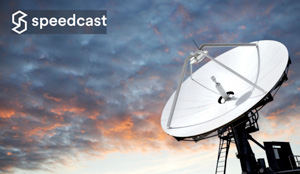
Airbus is the trusted partner for the UK’s secure military satellite communications (MILSATCOM) program.
In 2016, Speedcast built two 11m antenna systems at one of the company’s leading teleport facilities in Australia and has successfully provided secure hosting and maintenance services since that time. This contract award extends this successful partnership.
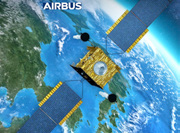
Artistic rendition of an Airbus
SKYNET satellite on-orbit.
In 2019, Airbus celebrated a remarkable 50 years of providing global secure military satellite communications to the UK Ministry of Defence, marked by the 50 year anniversary of the first SKYNET satellite.
“Australia is an ideal geographical location to access the SKYNET fleet from the Asia-Pacific region, and Speedcast’s facility serving this project is rated Tier 4 by the World Teleport Association, so it’s one of the best in the Eastern hemisphere,” said James Trevelyan, Senior Vice President of Enterprise and Emerging Markets at Speedcast. “Australia is also a Five Eyes intelligence alliance partner.”
Ball Aerospace enters final stages of building USSF’s WSF-M satellite
Ball Aerospace has completed the spacecraft bus for the Weather System Follow-on-Microwave (WSF-M) satellite, the U.S. Space Force’s (USSF) next- generation, operational, environmental satellite system.
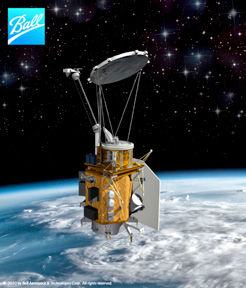
The company also finalized environmental testing on the Microwave Imager (MWI) instrument and has started final space vehicle assembly, integration and testing.
Upon delivery, WSF-M will provide mission data to Department of Defense’s (DoD) environmental prediction systems that support all warfighter domains.
In addition, it will broadcast real-time, actionable environmental intelligence to on-going military operations across the globe.
At the heart of the WSF-M payload is the Ball-built, MWI sensor that takes calibrated, passive, radiometric measurements at multiple, microwave frequencies to measure sea surface winds, tropical cyclone intensity and additional environmental data.
The ECP sensor will provide critical space weather measurements. WSF-M was designed to mitigate three high- priority DoD Space-Based Environmental Monitoring (SBEM) gaps: ocean surface vector winds, tropical cyclone intensity and the space weather gap, LEO energetic charged particles. It will also address three additional SBEM gaps: sea ice characterization, soil moisture and snow depth.
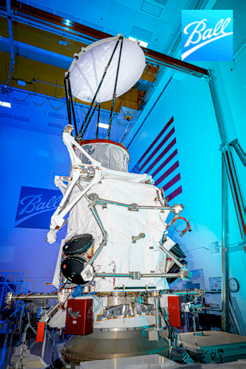
Ball Aerospace was recently awarded the contract modification to develop and build the second WSF-M space vehicle, expected to be completed by late 2027.
Ball Aerospace has played key roles on numerous operational weather satellite programs. The company’s Ozone Mapping and Profiler Suite (OMPS) instruments are operating on the Ball-built Suomi NPP and NOAA-20 satellites, launched in 2011 and 2017, respectively.OMPS is also on board the Joint Polar Satellite System-2 (JPSS-2), which launched on November 10, 2022.
Ball is on contract with NASA to build two additional OMPS instruments for JPSS-3 and JPSS-4. The Ball-built Ion Velocity Meter (IVM) space weather sensors are flying on five of the six Constellation Observing System for Meteorology, Ionosphere and
Climate-2 (COSMIC-2) satellites, a joint program with the U.S. Air Force, U.S. Space Force, Taiwan’s National Space Organization, NOAA and the University Corporation for Atmospheric Research that launched in 2019.
“The nearly simultaneous completion of the spacecraft bus and instrument testing mark a significant milestone for the WSF-M program,” said Hope Damphousse, vice president, Strategic Operations, Ball Aerospace. “We are moving forward with spacecraft integration of the MWI sensor, along with a government- furnished Energetic Charged Particle (ECP) sensor, which will be followed by a suite of space vehicle performance and environmental tests.”
VCSO inspires next generation of Guardians at Virginia Tech
More than 150 cadets arrived at Virginia Tech’s Goodwin Hall from January 20-22, 2023, for Detachment 857’s Space Training and Readiness Squadron (STARS) Align event focused on professional development.
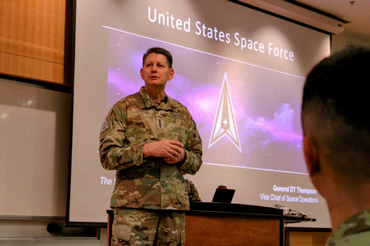
Vice Chief of Space Operations Gen. David D. Thompson
speaks to cadets about the evolution and future of the U.S. Space
Force, January 21, 2023, at an Air Force Reserve Officer
Training Corps event hosted at Virginia Tech., Blacksburg, Va.
Photo: Cadet Dylan Bowling.
Cadets traveled from 27 detachments, each with their own background and experience in the Air Force Reserve Officer Training Corps (AFROTC).
STARS Align was organized by cadets from Detachment 875 to build connections between future Guardians and Airmen.
Simultaneously, the team aimed to promote greater understanding of the U.S. Space Force mission and its role within the U.S. Armed Forces.
The event included a formal address by Vice Chief of Space Operations (VCSO) Gen. David D. Thompson.
Thompson became the first VCSO when the Space Force was created in December 2019.
In his speech, Thompson emphasized the evolution and future of the Space Force, as well as the importance of being able to rapidly improve upon our technology and strategies.
Thompson illustrated the U.S. Air Force’s storied history of effective strategic bombing and the service’s ability to adapt in real time to effectively neutralize threats before adversaries could inflict further harm.
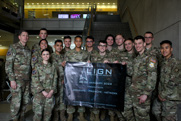
More than 150 cadets traveled from
27 detachments for the Space Training
and Readiness Squadron (STARS)
Align event.
Thompson said the Space Force needs to foster the same adaptability and resiliency as it works to develop its capabilities and protect critical assets, such as GPS and communication satellites.
Similarly, U.S. Space Force Col. Corey Ramsby, AFROTC Commander, discussed the future of training for cadets aiming to commission into the Space Force or Air Force.
Ramsby said cadets in the near future may observe a significantly different field training environment than those of previous years.
Current ideas include integrating the roles and responsibilities of various career fields to ensure cadets are exposed to a diversity of skillsets during their training.
Ramsby also noted AFROTC is placing a greater emphasis on the education and training of its cadre in order to grow an empowered and innovative next generation of Guardians and Airmen who are prepared to lead the future of the Space Force and Air Force.
Following the keynote remarks, cadets were able to speak to several, newly commissioned, Space Force officers, such as U.S. Space Force 2nd Lt. Grace Hall, a former cadet at Virginia Tech’s Detachment 875, who currently serves as a student within the Air Force Institute of Technology Civilian Institute Program.
“The STARS Align Space Training Weekend was an awesome opportunity for these cadets to better appreciate the importance of space to our national defense, the threats our nation faces in the space domain, and the amazing things being done in research and operations to counter those threats,” said U.S. Air Force Col. Greg Lowe, Detachment 875 commander. “No matter what their future holds, these cadets will leave with a great appreciation for the capabilities our Space Force brings to the joint fight.”

